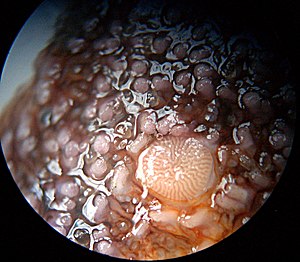Madreporite
This article needs additional citations for verification. (July 2018) |

The madreporite /ˌmædrɪˈpɔːraɪt/[1] is a light colored calcareous opening used to filter water into the water vascular system of echinoderms. It acts like a pressure-equalizing valve. It is visible as a small red or yellow button-like structure, looking like a small wart, on the aboral surface of the central disk of a sea star or sea urchin. Close up, it is visibly structured, resembling a "madrepore" (stone coral, Scleractinia) colony. From this, it derives its name.
The water vascular system of the sea star consists of a series of seawater-filled ducts that function in locomotion and feeding and respiration. Its main parts are the madreporite, the stone canal, the ring canal, the radial canals, the lateral canals, and the tube feet. The sieve-like madreporite allows entry of seawater into the stone canal, which connects to the ring canal around the mouth. Five or more radial canals extend from the ring canal, one in each arm above the ambulacral groove. From the radial canals extend many lateral canals, each of which leads to a tube foot. Each tube foot is a closed cylinder with muscular walls, having a sucker at the outer end and a bulb-like ampulla at its inner end within the body cavity.

References[]
- ^ OED[full citation needed]
- Echinoderm anatomy
- Echinoderm stubs
- Animal anatomy stubs